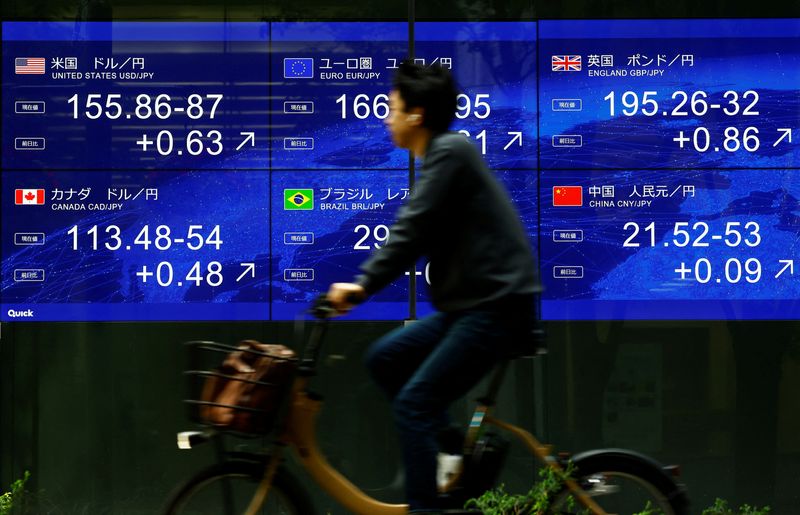By Ankur Banerjee and Rae Wee
SINGAPORE (Reuters) - Japan appears to have bought some time and respite for a tumbling yen through its latest bursts of suspected , yet it has also set itself up for a protracted war with a market that views the currency as a compelling sell, analysts say.
Traders estimate the Bank of Japan (BOJ) spent nearly $59 billion defending the currency this week, helping to put the yen on track for its best weekly performance in over a year.
The Japanese currency is up 5% from the 34-year low of 160.245 it plumbed on Monday. Tokyo is yet to confirm it had intervened.
But this week's rally has been anything but linear in a market decidedly bearish on the currency, given the massive gap between its ultra-low yields and those in other major economies.
The yen has swung wildly during the suspected intervention bouts, gaining nearly 5 yen in a matter of minutes and relinquishing part of that speedily.
"Nothing's actually changed," said Rob Carnell, head of Asia-Pacific research at ING. "I think this has provided a momentary pause in what will inevitably be tested by markets again, who will see this as free money when they take on the BOJ...."
Carnell says the yen has become "a trader's dream", as they can make easy money by simply buying dollars for yen, waiting for the pair to rise and then selling it as the BOJ steps in to support the yen.
"You'd be mad not to test it, knowing that they will step in at some stage," he said.
Before this week's suspected forays into the market, Japanese authorities last intervened between September and October in 2022 spending around $60 billion to defend the currency.
The yen was then near 152 per dollar, but within two months of that intervention it was sliding again. It had shed 20% more of its value against the greenback when it hit 1990 lows this week.
"Because of the wide rate differentials, speculators will still be on the other side of this trade," said Kaspar Hense, a senior portfolio manager at BlueBay Asset Management.
The spread between the benchmark 10-year U.S. Treasury and Japanese government bond yields is nearly 4 percentage points.
NO TARGETS
Ben Bennett, Asia-Pacific investment strategist at Legal And General Investment Management, says Japan's Ministry of Finance, whose mandate it is to manage the yen, is well aware of how monetary settings are stacked against the yen and is only acting to contain the pace of depreciation.
"Intervention comes at a cost, and I think the MOF would be unwilling to throw money at a specific target," he said.
Even after the BOJ’s landmark move away from negative rates in March, the yen remains the cheapest major currency to borrow and short-sell, sealing its fate.
Analysts say that complicates forecasts for the yen, but it appears like the 160 level is one the BOJ wants to protect.
Hirofumi Suzuki, chief currency strategist at Sumitomo Mitsui (NYSE:SMFG) Banking Corporation in Tokyo, reckons Japanese authorities find the decline after their March meeting "speculative and unacceptable" and might be aiming to get the yen back to 155 to a dollar where it was before that momentous policy decision.
Yujiro Goto, head of currency strategy for Japan at Nomura, feels the authorities merely want to help their importers get the dollars they need.
"I think 150 is ideal for Japanese importers. I think around the 152–152.50 level is probably what MOF wanted to have, but it didn’t hit that level, so there is a risk that MOF might come back for another round."
Speculators also realise that the government's war chest isn't bottomless. Japan has about $1.3 trillion in currency reserves, but only around $155 billion that it holds in dollar deposits are liquid.
Meanwhile, Federal Reserve rate cut bets are receding as the U.S. economy and labour markets stay hot. Speculative short yen positions have run up to their largest in 17 years.
Fred Neumann, chief Asia economist at HSBC, says Japan is only trying to end the asymmetric one-sided speculation, rather than defend any yen levels.

"Given the reality of higher U.S. interest rates for longer, this is an expectations management exercise. It's not an exercise to necessarily deliver a rapid appreciation of the yen," he said.
($1 = 152.8600 yen)